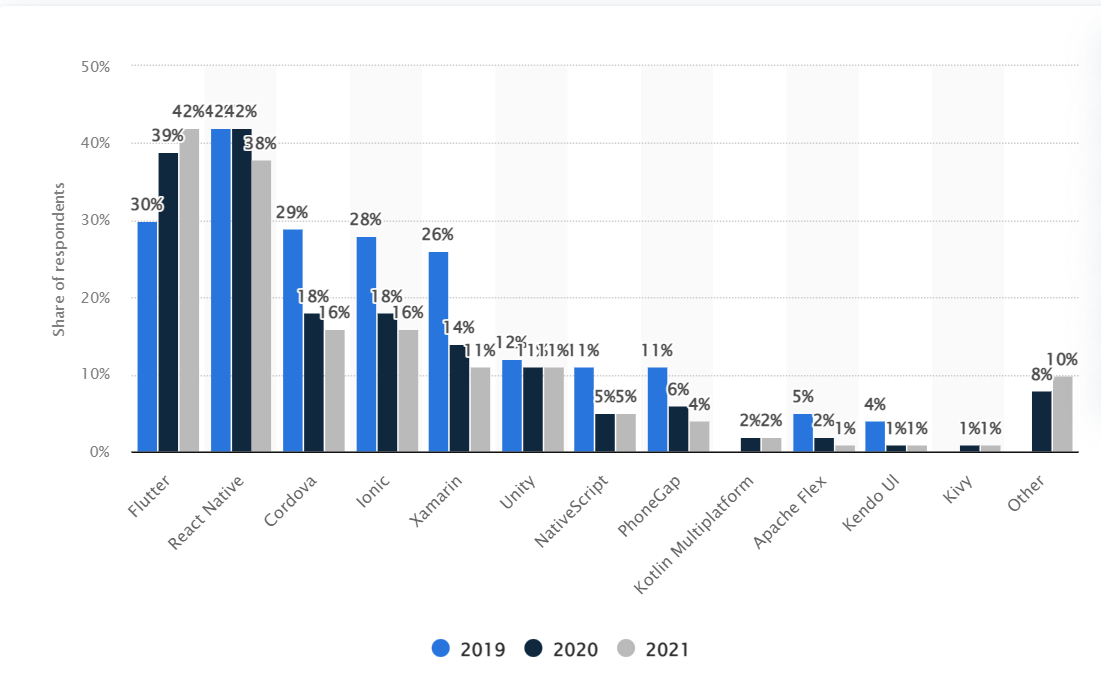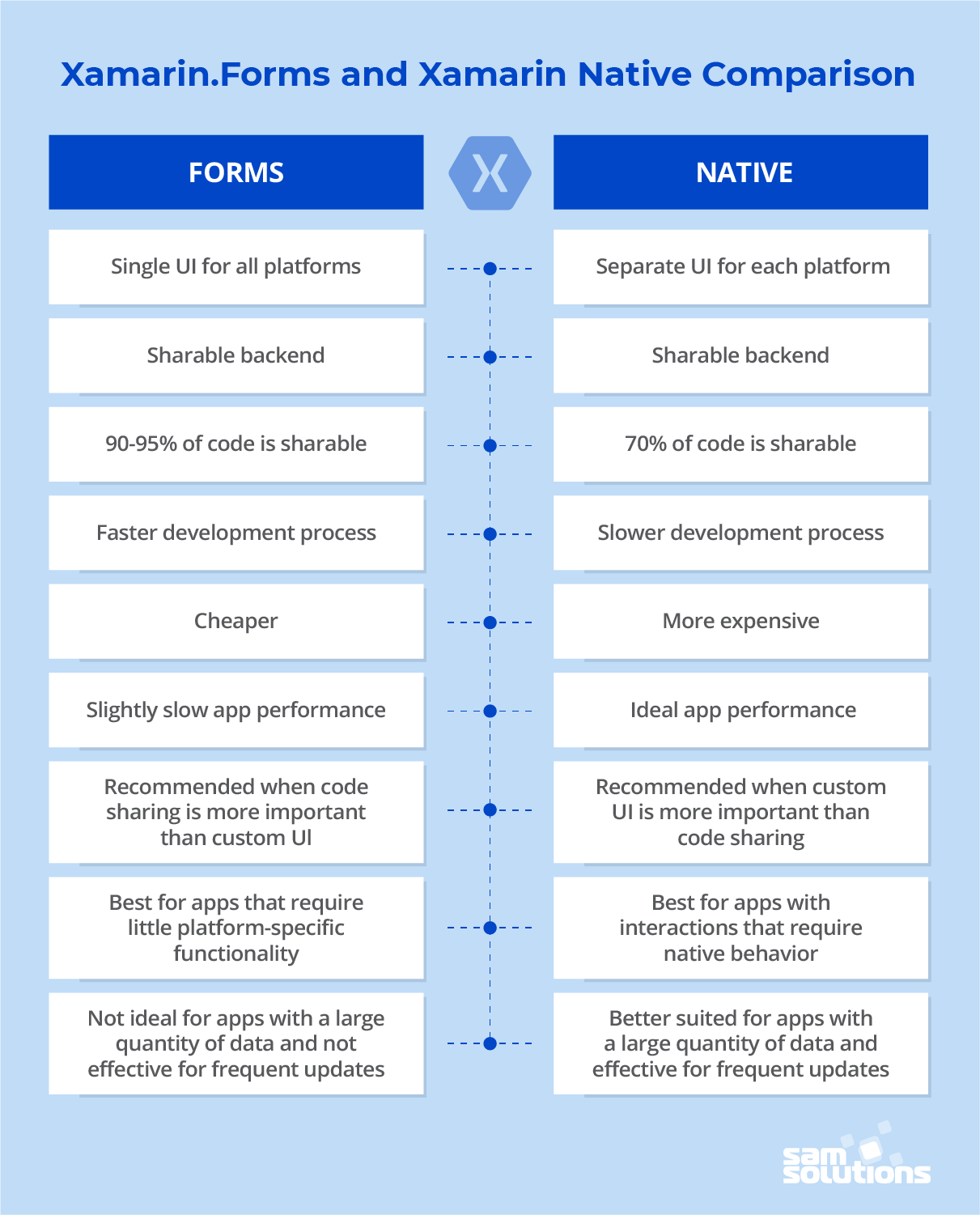A mobile strategy has become a must for businesses striving for online success because an increasing number of users access the internet via smartphones. Today, going mobile means creating a solution compatible with several mobile platforms, mainly Android and iOS. That’s why it’s important to know how to create cross-platform mobile apps and what tools are best to use.
This article provides a detailed overview of a popular cross-platform development tool — Xamarin.
Mobile Market Penetration in Figures
The statistics are a core indicator in evaluating the significance of mobile devices in today’s life. Let’s take a look at the market as of 2022:
- According to Statista, the number of smartphone users today surpasses 6.5 billion people, which is over 83% of the world’s population.
- There are 4.32 billion unique mobile internet users in 2021.
- Mobile internet traffic accounts for 56.89% of the global web traffic.
- The market share of different mobile operating systems is estimated as follows: Android — 71.6%, iOS — 27.68%, with other players such as Samsung, KaiOS, Windows Phone, etc. taking less than 1% each.
- The survey by JetBrains revealed that 53% of developers use cross-platform technologies and frameworks for creating mobile apps.
This data proves that mobile solutions have become an integral part of our life and will significantly impact all spheres in the years to come. Therefore, mobile app development services will be in high demand.
Enjoy the advantages of a mobile presence with SaM Solutions’ cross-platform mobile development services.
What’s more, mobile frameworks for cross-platform coding are growing in popularity because applications compatible with several platforms offer a more flexible and complete customer experience.
Let’s move on to give you a comprehensive overview of Xamarin, a popular tool for cross-platform development.
What Is Xamarin?
Microsoft acquired Xamarin, which had been initially based on the Mono project, in 2016 and integrated it into the .NET platform.
Today, this is a popular open-source framework for developing cross-platform mobile applications. A single technology stack of Xamarin, C# and .NET, together with the reuse of up to 95 percent of the code, enables the quick and easy creation of mobile apps for Android, iOS and Windows operating systems.
Xamarin is a software company that created the Common Language Infrastructure (CLI) implementations and was purchased by Microsoft in 2016.
Xamarin is a development platform that aims to create mobile applications for iOS, Android and Windows.
How good is Xamarin? Judging by the statistics, Xamarin’s products are quite popular around the world. According to the company’s reports, more than 15,000 organizations and about 1.4 million developers are using them in 120 countries. Among the most renowned customers are Bosch, Siemens, Slack, Pinterest, and others. The fact that several industry leaders have based their solutions on this platform proves its reliability and efficiency.
Statista also proves the popularity of Xamarin by including it in the list of the most used frameworks among software engineers, preceded by Flutter, React Native, Cordova and Ionic.
Cross-platform mobile frameworks used by software developers worldwide from 2019 to 2021

Platforms Supported by Xamarin
Currently, Xamarin supports the creation of reusable code for the following platforms:
- Android (including the Android Wear version for developing software for wearable devices)
- iOS (including watchOS for Apple Watch and tvOS for Apple TV)
- Windows (UWP and WPF)
Note! Windows Phone is not supported as of Xamarin 3.x
- Linux (GTK)
- Mac
- Tizen
How Xamarin Works
The basic principle of Xamarin work is code sharing. In simple words, software developers write the code once and then apply it to various platforms with slight modifications, instead of writing the platform-specific code for an Android project and an iOS project from scratch.
.NET, as the foundation of Xamarin, performs memory allocation, the automatic garbage collection, and other tasks.
Xamarin Development Approaches
There are two ways of developing cross-platform applications using Xamarin.

- Xamarin.Forms technology allows you to design a visual user interface once, attach some C# logic to it and share this codebase across Android, iOS and Windows platforms with some minor code changes. In this case, the UI code and the backend are pulled together for all solutions. This approach ensures a faster development time, and it’s cheaper. However, the application performance is not ideal.
- Xamarin Native includes Xamarin.iOS, Xamarin.Android and Xamarin.Mac libraries that allow you to design separate UI applications for each platform. In this case, the UI code is unique for each solution, but the backend is shared, just as with Xamarin.Forms. With this approach, the development process is slower and more expensive, but it ensures perfect native behavior by apps.
Xamarin Cross-Platform Development Features
- Base Class Library (BCL) — a standard .NET library of classes with powerful features that Xamarin can access and make use of, such as serialization, XML, networking, etc.
- Visual Studio — an integrated development environment (IDE) that Xamarin uses to build apps. It provides essential features such as code autocomplete, integrated source control, and more.
- Interoperation with programming languages — Xamarin can invoke libraries written in C, C++, Java and Objective-C, which significantly expands code-writing opportunities.
- Xamarin Component Store — a built-in collection of free and paid third-party components (services, libraries, UI controls).
- Backend integrations — you can integrate your Xamarin-based applications with powerful backend platforms, including SAP, Azure, and Parse.
Building Cross-Platform Apps with Xamarin: Advantages
Cross-platform mobile development is becoming widespread as it has certain advantages over native development. Why use Xamarin for creating cross-platform solutions? In short, because this is a developer’s dream tool — they can create code once and use it across various platforms, without impairing the app’s performance, maintainability, or user experience.
Xamarin is a universal tool that allows you to create a single application logic using C# and .NET for three mobile platforms at once.
Let’s discuss in more detail the reasons to use Xamarin for cross-platform mobile development.
1. Single Technological Stack
One of the main pros of Xamarin is that a single language, C#, creates all kinds of solutions. Moreover, there’s no need to switch between environments — you can do everything in Visual Studio. This is convenient and time-effective because developers perform the same process using one language instead of two different languages. Hence, Xamarin is easy to learn.
2. Native User Experience
Xamarin has full access to native APIs and toolkits used on Android, iOS and Windows platforms. Consequently, it can provide native (or near-native) design and performance for every application.
The nativeness is possible due to the usage of platform-specific elements and technologies available in C# and Visual Studio:
- Xamarin.Android and Xamarin.iOS give .NET developers access to complete Android and iOS SDKs.
- Xamarin.Essentials library provides access to core overlapping native APIs.
- Xamarin.Forms exposes a user interface (UI) toolkit for all mobile platforms.
Thus, you can take advantage of all the unique elements in one place and create a single solution with platform-specific interfaces.
3. Shareable Code
Xamarin is often referred to as a “write once, use everywhere” development platform because it creates code that’s 60–95% reusable. A single codebase can run on various platforms, providing native performance, and may require slight changes only.
4. Time and Costs Saving
A shareable codebase and a single technological stack save time spent on the development cycle. You code once and can then reuse most of this code for other solutions, making only slight adjustments and not spending time on the same procedure. This means you can release your product faster.
Since everything is written in C# and within the .NET framework, there is no need for separate teams to work on the app. The development, testing and deployment are significantly streamlined when performed by a single team. This eliminates additional expenses and ensures quick time to market.
It is especially beneficial for companies with limited human and hardware resources.
4. Testing
The platform offers comprehensive solutions to test and monitor application user interface and performance — Xamarin Test Cloud and Xamarin Test Recorder. These tools allow you to run automated tests on multiple real devices in the cloud and find performance issues before the release.
5. Simplified Maintenance
It is remarkably easy to maintain apps developed with Xamarin.Forms as they share code. If you need to update applications and address some issues, just do it in the source code, and all changes will be automatically applied to other solutions. Again, it saves time, developer involvement and finances.
What’s more, the Xamarin community deserves respect for providing comprehensive customer support backed with well-organized documentation and training opportunities.
6. Technical Support by Microsoft
The framework guarantees stability, continuous technical backing and fast issue resolution because it’s supported by Microsoft — one of the world’s leading tech software companies.
Moreover, Microsoft provides access to robust educational opportunities, including Xamarin courses, which can be self-paced, and comprehensive tech documents on the official Microsoft Learn platform. This means that developers are not working in a vacuum and can receive support while improving their expertise.
Building Cross-Platform Apps with Xamarin: Challenges
Like any other software product, Xamarin is not a perfect fit for all projects. Here are some challenges that may prevent you from using this cross-platform development tool.
1. Heavy Applications
Xamarin-based solutions can be twice as big as native files and require extra adjustments because they use numerous core libraries and functionality. A couple of additional megabytes may be critical for some projects.
2. No Complicated Graphics
It’s tough to build appealing Xamarin solutions loaded with complex graphic elements or animation. Hence, this platform is not the best choice for creating apps with advanced visualization or gaming apps.
However, nothing is impossible: the open-source platform allows developers to create new APIs and plugins to expand the capacity and add new possibilities.
3. Updating Lag
When updates for Android, iOS and Windows are released, Xamarin developers can’t use them immediately. They need some time to properly integrate new features into the ecosystem, which causes an updating delay (of one or two days) and may affect the company’s reputation.
4. Performance
Though Xamarin-based applications provide near-native performance, they are still slower than native solutions. If performance is critical for a client company, Xamarin may not be the best fit.
Xamarin Integrated Development Environment (IDE)
You can use several IDEs for developing Xamarin-based applications.
Initially, there was Xamarin Studio, a proprietary environment for Mac and Windows app development (later only for Mac apps). This tool is now obsolete and has been replaced by Visual Studio for Mac.
Currently, Visual Studio is the basic environment for working with Xamarin. It has four versions:
- Visual Studio Community — an option for small teams, students and open-source projects.
- Visual Studio Professional — a set of powerful tools for code-writing for small teams of professional developers.
- Visual Studio Enterprise — an environment for large, complex projects.
- Visual Studio Code (VS Code) — not a full-featured IDE, but a lightweight code editor providing basic tools for creating simple applications.
Latest News: .NET MAUI
Xamarin is not standing still. The next milestone in platform development is the release of .NET MAUI, scheduled for Q2 2022. MAUI stands for Multiplatform App UI, and will be a merger of .NET and Xamarin.Forms.
The new product will feature the improved Xamarin.Forms architecture and low-code elements, and will provide access to all native APIs. Xamarin.Native will become part of the .NET 6 platform.
Microsoft will still support Xamarin for some time, but they won’t release new versions.
Developers are looking forward to getting acquainted with MAUI and leveraging its capabilities for new projects. We at SaM Solutions stay tuned for updates and will guarantee the smooth migration of our existing Xamarin-based apps to the new platform.
Our Experience with Xamarin
Xamarin experts at SaM Solutions have been providing services for more than eight years and have successfully completed more than ten projects.
Our Xamarin competencies include:
- Business needs and requirements analysis
- App development
- Support and maintenance
- UI/UX design
- Legacy native mobile app improvement and performance optimization
- Mobile testing services
One of our clients needed a solution with two separate mobile apps for two specific user groups to collaborate. Developing different apps for iOS and Android would have been time-consuming and would have resulted in high expenses along the way. That’s why the client opted for Xamarin cross-platform development.
As a result, the cross-platform solution was developed and successfully launched on iOS and Android. Our team was involved in the following stages of product creation:
- Requirement definition
- Application development
- Testing
- Design
- Execution
- Support and maintenance
In another project, the challenge was to develop a mobile application for both iOS and Android platforms that would control electronic locks in smart home systems.
Our Xamarin team was responsible for the system architecture design, development, quality assurance and automated testing. They successfully created and launched the IoT mobile application.
Making a Mobile Choice
Developing mobile applications with Xamarin makes programming more efficient and cost-effective while maintaining all native apps’ features. But this is not a “one size fits all” solution.
In many cases, we have found Xamarin to be a successful tool that dramatically cuts both creation- and maintenance-related costs due to a sharable codebase without compromising quality. So, we see it as a potential game-changer for many.
Still, Android and iOS continue to rule the mobile industry, and you have to weigh the pros and cons of native vs. cross-platform development when choosing the fastest, cheapest and most efficient way to build your solution.
Specialists at SaM Solutions have in-depth experience in creating both native and cross-platform mobile apps. We are a reliable partner, so don’t hesitate to contact us for a detailed discussion of your future project.



























 5 Reasons Why Your Business Needs a Mobile eCommerce Application
5 Reasons Why Your Business Needs a Mobile eCommerce Application Using Salesforce to Improve Your Sales Pipeline: Five Tips
Using Salesforce to Improve Your Sales Pipeline: Five Tips Cross-Platform Mobile Development: Five Best Frameworks
Cross-Platform Mobile Development: Five Best Frameworks How to Develop Custom Accounting Software
How to Develop Custom Accounting Software 10 Best Web Development Frameworks in 2024
10 Best Web Development Frameworks in 2024








![[Tech Talk] What Developers Should Know About SQL Optimization, Part 1: Fundamentals](https://www.sam-solutions.com/blog/wp-content/uploads/fly-images/30279/SQL-video-cover-370x238.webp)


